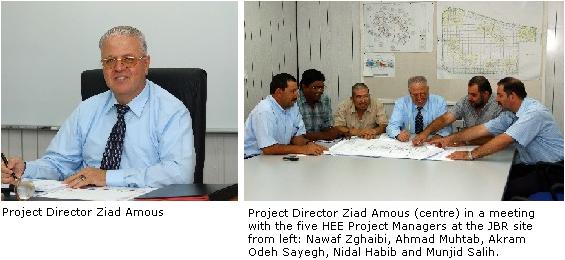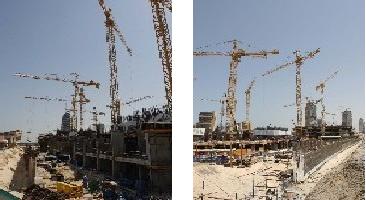|
The
decision to allow expatriates to buy property in the
emirate of Dubai has fuelled a massive building boom as
prestigious new developments are constructed in record
time to meet the demand from residents and international
investors for luxury homes in one of the most dynamic
cities in the world.
Among the wave of new developments in
the upcoming Dubai Marina area is the Jumeirah Beach
Residence, which comprises a staggering 35 residential
towers and five hotels overlooking the 2km
man-made waterfront of the marina and the crystal blue
waters of the Arabian Gulf.
The construction
project is so massive it has been divided into seven
different zones, each of which comprises between three
and eight high-rise towers. The region’s leading
contracting companies were invited to pitch for the
construction contracts for each and the largest of the
seven zones – zone four – was awarded to Al Habtoor
Engineering Enterprises with Arif & Bintoak as
consultants and MACE as project managers.
Al Habtoor
Engineering Enterprises has become synonymous with the
modern day development of Dubai, having already
constructed a number of the emirate’s landmark
buildings. From the ultra-modern Sheikh Rashid Terminal
at Dubai International Airport to the breathtaking
splendour of the Burj Al Arab, the company has played a
starring role in Dubai’s success story, and this latest
development marks a new milestone in its proud 34-year
history.
The Dh1 billion
contract awarded by the client, the Dubai Technology and
Media Free Zone (TECOM), involves the construction of
eight residential towers covering a built-up area of
450,000 square metres, which is the biggest project by
volume that the company has ever undertaken.

“It is the
largest and one of the most prestigious projects in the
history of Al Habtoor Engineering Enterprises,”
project director Ziad Ammous
explains. “The Dubai Marina area is one of the
major development projects taking place in Dubai at the
moment and, because it is very much aimed at
international investors, it is a showcase for the city
which is what makes the project so important.”
Three of the eight towers being
constructed are 52 floors high, four are 42-stories and
the eighth, which is still being designed, will be
26-stories. Once complete they will house a range of
different sized apartments, with all eight buildings
surrounded by a low-rise ‘podium’ area comprising car
parking and amenities such as retail shops, swimming
pools and children’s play areas covering an area of
78,000 square metres.
“For Al Habtoor this is not a
difficult project - it is well within our capabilities
and know-how,” Mr Ammous says. “But there is a challenge
involved in having eight towers under construction at
the same time as it requires a lot of co-ordination, and
it is a fast-track job so there is an element of time
pressure as well.”
The first task for the Al Habtoor
Engineering Enterprises team was undertaking a complete
redesign of the original plans for the buildings to make
them more cost-effective and practical to build.
“The original concept involved using
post-tension, pre-cast slabs, but we are modifying the
design by introducing cast in-situ, post-tension slabs
which make it easier and quicker to construct,” Mr
Ammous explains. “The re-design brings cost savings for
the client without sacrificing any of the quality or
integrity of the structures. The construction system
will be traditional with vertical structural elements
and horizontal slabs, while the external cladding for
the towers will be composed of pre-cast cladding,
including aluminium windows. Three of the towers are
square rectangle in plan but four of them are not as
easy because they are angled, or ‘cranked’ which
requires special attention.”
A joint venture between Al Habtoor
Engineering Enterprises and STFA had executed the piling
works for the sector, which meant the construction team
could start as soon as that work had been completed
because the company already had a presence on the site.
“The construction duration is 24
months which is very challenging for the amount of work
involved,” Mr Ammous says. “The clock started ticking on
May 2 this year when we started on site. One of the
things that makes it difficult to stay on schedule is
handling huge numbers of pre-cast elements which have to
be delivered to site by lorry and could cause congestion
in the area.
“The other difficulty is that the
towers are very close to each other. We expect to have
about 13 tower cranes on the site and to have them all
operational without clashing with each other is not an
easy task - it’s very complicated and needs a very
thorough study.”
Mr. Ammous,
who has worked on a number of projects including the
Officer’s Club Accommodation, Marina Mall and the new
ADNOC Headquarters in Abu Dhabi since joining Al Habtoor
Engineering Enterprises as a construction manager in
1995, has divided the site into five different sectors
for constructability, with himself overseeing the entire
project.

“Each sector is managed by a
different construction team led by a project manager
with a construction manager, project engineers, site
engineers, foremen and labourers,” he explains. “The
sectors are running parallel but they are individual and
we have co-ordination meetings between the different
parties to follow-up progress and the needs of the site.
“With a fast-track job there are
possibilities for mistakes and errors so the challenge
is to monitor and control the quality of work to avoid
any problems or mistakes which could cause a delay.”
With an
estimated 80 percent of the apartments having already
been sold in the eight towers of the Jumeirah Beach
Residence being constructed by Al Habtoor Engineering
Enterprises, there is a pressing need to ensure the work
is completed on time as hundreds of people are waiting
to move into their new homes in one of the most exciting
developments currently under construction in Dubai. | 